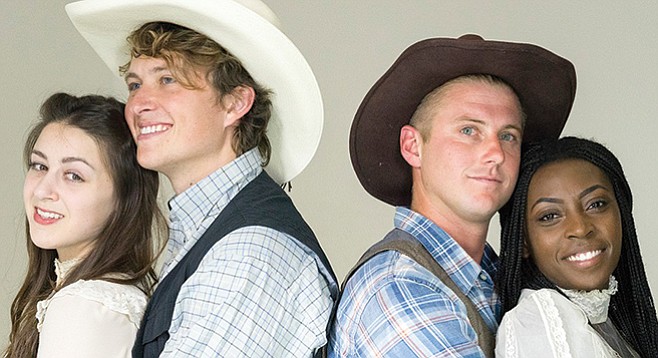 Facebook
Facebook
 X
X
 Instagram
Instagram
 TikTok
TikTok
 Youtube
Youtube

If you have half a heart, you’ll leave New Village Arts’ Oklahoma! happily humming “Oh What a Beautiful Mornin’” while visions of scurrying chicks and ducks paint a picture of pastoral grandeur second to none. The infectious music is just too good. It has been for seventy years and will be for seventy more if community theatres keep staging Rodgers & Hammerstein. It’s only a matter of time before Curly (Jack French) woos Laurey (Charlene Koepf), relinquishing his errant cowboy ways for an idyllic life on the farm.
You’d be forgiven for thinking Oklahoma the most beautiful place on Earth, and like any state, Oklahoma no doubt boasts natural beauty, friendly people, and a unique sense of itself as 1/50th of the U.S.
Yet, I remember my grandmother describing Oklahoma as the most miserable place she ever domiciled: a pitiless land where storm-blown dust crept incessantly beneath the door. As her time there would have coincided with the lean years following the dust bowl, I’m sure she experienced Oklahoma at its worst, so her opinions come with a grain of salt, but there’s not much wiggle room to adjust for context with tales of bitter winter’s cold and thunderstorms that shake the ground.
Can you imagine a 20-year-old woman (who, till that time, hadn’t gone too far from Newburyport, Massachusetts) alone on an army base in the middle of Oklahoma? Sure, she would have heard about tornadoes, but when that first twister came screaming down the plains, imagine her trying to console her frightened baby daughter. To top it off, she knew her husband was bound inevitably for Europe to face the Wehrmacht, and that he might well not come home at all.
Coincidentally, it’s into this dark period of history, that Oklahoma! offers a fresh (if not strictly accurate) vision of a dustbowl state, one characterized by proud farmers facing a brand new day; a far cry from Steinbeckian images of impoverished Okies fleeing to California. Today, up to and including New Village Arts’ production, the play’s quintessentially American ebullience over the burgeoning West is no less inspiring than it was when audiences needed it most; i.e. in 1943 in the face of catastrophic war and a decade of Depression, though I bet my grandmother would have taken an understandably dim view to the title number.


If you have half a heart, you’ll leave New Village Arts’ Oklahoma! happily humming “Oh What a Beautiful Mornin’” while visions of scurrying chicks and ducks paint a picture of pastoral grandeur second to none. The infectious music is just too good. It has been for seventy years and will be for seventy more if community theatres keep staging Rodgers & Hammerstein. It’s only a matter of time before Curly (Jack French) woos Laurey (Charlene Koepf), relinquishing his errant cowboy ways for an idyllic life on the farm.
You’d be forgiven for thinking Oklahoma the most beautiful place on Earth, and like any state, Oklahoma no doubt boasts natural beauty, friendly people, and a unique sense of itself as 1/50th of the U.S.
Yet, I remember my grandmother describing Oklahoma as the most miserable place she ever domiciled: a pitiless land where storm-blown dust crept incessantly beneath the door. As her time there would have coincided with the lean years following the dust bowl, I’m sure she experienced Oklahoma at its worst, so her opinions come with a grain of salt, but there’s not much wiggle room to adjust for context with tales of bitter winter’s cold and thunderstorms that shake the ground.
Can you imagine a 20-year-old woman (who, till that time, hadn’t gone too far from Newburyport, Massachusetts) alone on an army base in the middle of Oklahoma? Sure, she would have heard about tornadoes, but when that first twister came screaming down the plains, imagine her trying to console her frightened baby daughter. To top it off, she knew her husband was bound inevitably for Europe to face the Wehrmacht, and that he might well not come home at all.
Coincidentally, it’s into this dark period of history, that Oklahoma! offers a fresh (if not strictly accurate) vision of a dustbowl state, one characterized by proud farmers facing a brand new day; a far cry from Steinbeckian images of impoverished Okies fleeing to California. Today, up to and including New Village Arts’ production, the play’s quintessentially American ebullience over the burgeoning West is no less inspiring than it was when audiences needed it most; i.e. in 1943 in the face of catastrophic war and a decade of Depression, though I bet my grandmother would have taken an understandably dim view to the title number.
Comments